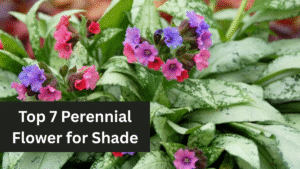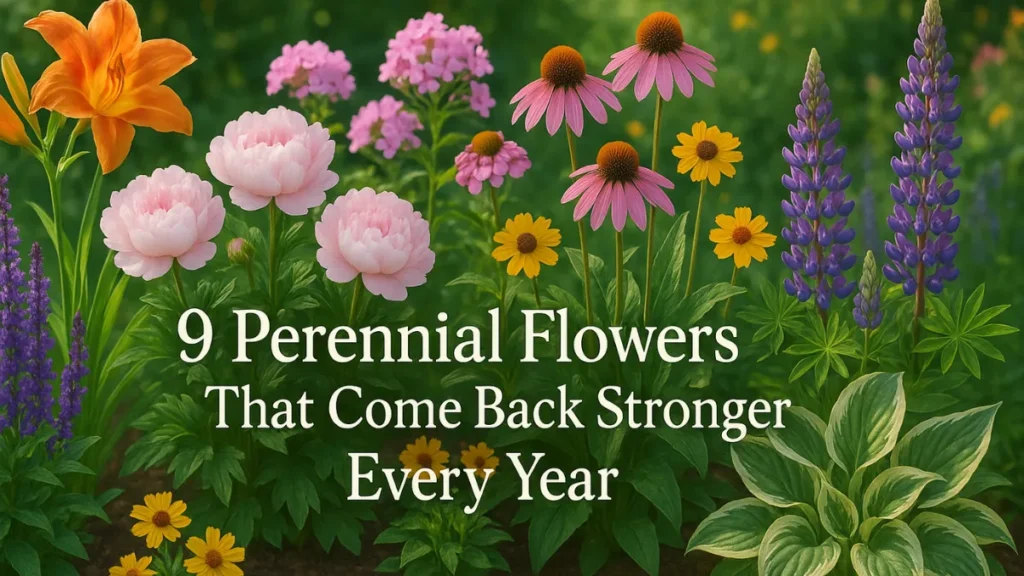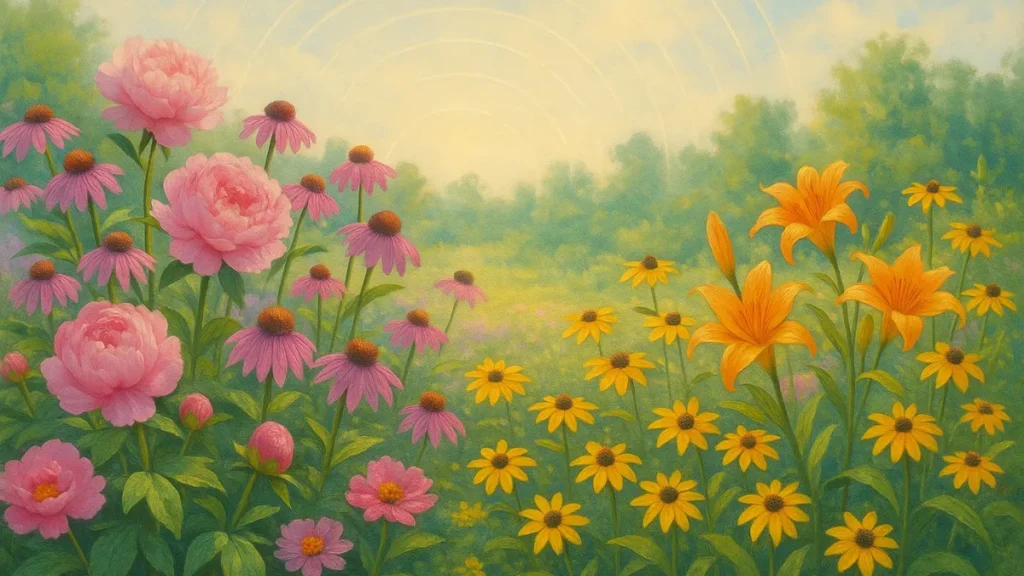If you’re looking to add color, texture, and interest to your shady garden, perennial flowers are the perfect solution. These plants not only thrive in low-light conditions but also come back year after year, offering a long-lasting, low-maintenance solution for shaded areas.
Whether you have a garden under the canopy of tall trees, or simply a space that receives limited sunlight, there are a variety of perennial flowers that will flourish in these conditions. From early bloomers like hellebores to the late-summer beauty of astilbes, these shade-loving flowers bring vibrant colors and delicate textures to any landscape.
In this blog, we’ll explore the top 7 perennial flowers that thrive in shade, each offering something unique for your garden. These plants not only beautify your outdoor space but also attract pollinators, making them a great choice for wildlife-friendly gardening.
1. Hellebore
Hellebore, commonly known as Lenten rose, is a beautiful and versatile perennial that thrives in shaded environments. It is prized for its ability to bloom early in the spring, often even when snow is still present. Hellebores have large, attractive flowers that come in a range of colors, from white to pink, purple, and even green.
Their leathery, evergreen leaves add structure and interest to the garden, even when the plant is not in bloom. The plant thrives in well-drained, humus-rich soil and tolerates dry shade well. In addition to their striking appearance, hellebores are known for their resilience and low maintenance requirements, making them a great choice for gardeners seeking a long-lasting plant in the shade.
Planting hellebores near the base of trees or along woodland edges is an ideal way to showcase their beauty in a shaded garden.
2. Columbine
Columbine is a unique and graceful perennial that offers both vibrant colors and a delicate, airy structure to shaded gardens. With its characteristic spurred flowers that can be red, yellow, purple, or blue, columbine stands out in any landscape.
These plants are relatively easy to grow and will thrive in moist, well-drained soil with partial to full shade. Columbines are known for attracting hummingbirds and butterflies, making them an excellent choice for wildlife gardens.
They also have a long blooming period, typically from late spring to early summer, which adds color to the garden when many other plants are just beginning to emerge. Their fern-like foliage also provides texture and interest year-round. Columbines are versatile and can be used in mixed borders, woodland gardens, or as ground cover in shady areas.
3. Carolina Allspice
Carolina allspice, also known as sweetshrub (Calycanthus floridus), is a deciduous shrub that thrives in shaded to partially shaded conditions. Its unique, fragrant flowers bloom in late spring to early summer and have a rich, spicy scent that is reminiscent of a combination of fruits and spices.
The flowers are typically deep red or maroon, adding a warm splash of color to shaded areas. Carolina allspice grows well in moist, well-drained soils and tolerates both dry and wet conditions, making it a versatile plant for different garden settings.
This shrub also features attractive, glossy green foliage that turns yellow in the fall, providing additional interest throughout the seasons. Its ability to thrive in shade and its fragrant flowers make it a great choice for gardens that want to combine beauty and functionality.
4. Bleeding Heart
Bleeding heart (Dicentra spectabilis) is a stunning perennial that is well-loved for its heart-shaped flowers and elegant, arching stems. It blooms in late spring to early summer, producing delicate pink, white, or red flowers that resemble tiny hearts with a droplet at the tip.
These flowers are not only eye-catching but also attract pollinators like hummingbirds and bees. Bleeding heart plants thrive in moist, well-drained soil and prefer partial to full shade, making them ideal for woodland gardens or shady borders.
The plant’s fern-like foliage is also an attractive feature, adding texture to the garden even after flowering has ended. Bleeding hearts do well in zones 3-9 and can live for many years with proper care, making them a reliable and long-lasting addition to shady areas.
5. Black Cohosh
Black cohosh (Actaea racemosa), also known as baneberry, is a native North American perennial that adds an elegant, woodland charm to any shaded garden. Known for its tall, slender flower spikes, black cohosh blooms in late summer to early fall, producing clusters of tiny white flowers that attract pollinators.
The plant’s dark, almost black stems and bold, glossy foliage provide year-round interest. Black cohosh thrives in moist, well-drained soil and prefers partial to full shade, making it perfect for woodland gardens or shaded borders.
It is particularly known for its ability to tolerate a variety of soil types, from clay to loamy soil. Its height and dramatic appearance make it a striking focal point in the garden, especially when paired with other shade-loving plants like ferns or hostas.
6. Barrenwort
Barrenwort (Epimedium) is an excellent ground cover plant for shaded gardens. Known for its heart-shaped leaves and delicate flowers, barrenwort offers both ornamental value and practical benefits in shady areas.
The plant blooms in early spring, producing small, dainty flowers that come in shades of yellow, pink, and white. Its evergreen or semi-evergreen foliage provides year-round interest, with some varieties exhibiting striking red or bronze hues in the fall.
Barrenwort thrives in moist, well-drained soils and tolerates dry shade once established. It’s a great choice for underplanting shrubs or trees, as it adds texture and color to areas where other plants may struggle to grow. Additionally, barrenwort is deer-resistant, making it ideal for gardens where wildlife may be a concern.
7. Bugbane
Bugbane (Cimicifuga racemosa), also known as black cohosh or snake root, is another attractive perennial that thrives in shaded areas. Known for its tall, striking flower spikes, bugbane produces white or cream-colored flowers in late summer to early fall.
The flowers are arranged in feathery, plume-like clusters, which create an airy, ethereal effect in the garden. Bugbane’s dark green, glossy foliage provides a bold contrast to the lighter blooms, and its height makes it an excellent choice for the back of a border or as a statement plant in a woodland setting.
Bugbane is particularly well-suited for moist, well-drained soil and partial to full shade. Once established, it is relatively low-maintenance, making it a great addition to shaded gardens that require little attention.
Bottom Line
Adding perennial flowers to shady areas in your garden is a wonderful way to enhance your outdoor space with vibrant colors and textures. The plants on this list, like hellebores, astilbes, and columbines, are specifically chosen for their ability to thrive in low-light conditions, offering beauty and resilience for years to come.
With proper care, these perennials will bring life to even the darkest corners of your garden, attracting pollinators and creating a serene, attractive environment. Choose the right combination to ensure your shaded garden becomes a peaceful, blooming sanctuary year after year.
FAQs
Can perennial flowers grow in full shade?
Yes, many perennials are adapted to thrive in full shade, such as hellebores, astilbes, and bleeding hearts.
How often should I water shade-loving perennials?
Shade-loving perennials generally need consistent moisture, but it’s essential to avoid over-watering. Water when the soil feels dry to the touch.
Do these perennials attract pollinators?
Yes, many shade-loving perennials like columbine and Indian pink attract pollinators, including bees and hummingbirds.
Can I plant these perennials in containers?
Yes, many shade-loving perennials can thrive in containers, especially those with moist, well-drained soil. Just ensure they have enough space for root growth.



